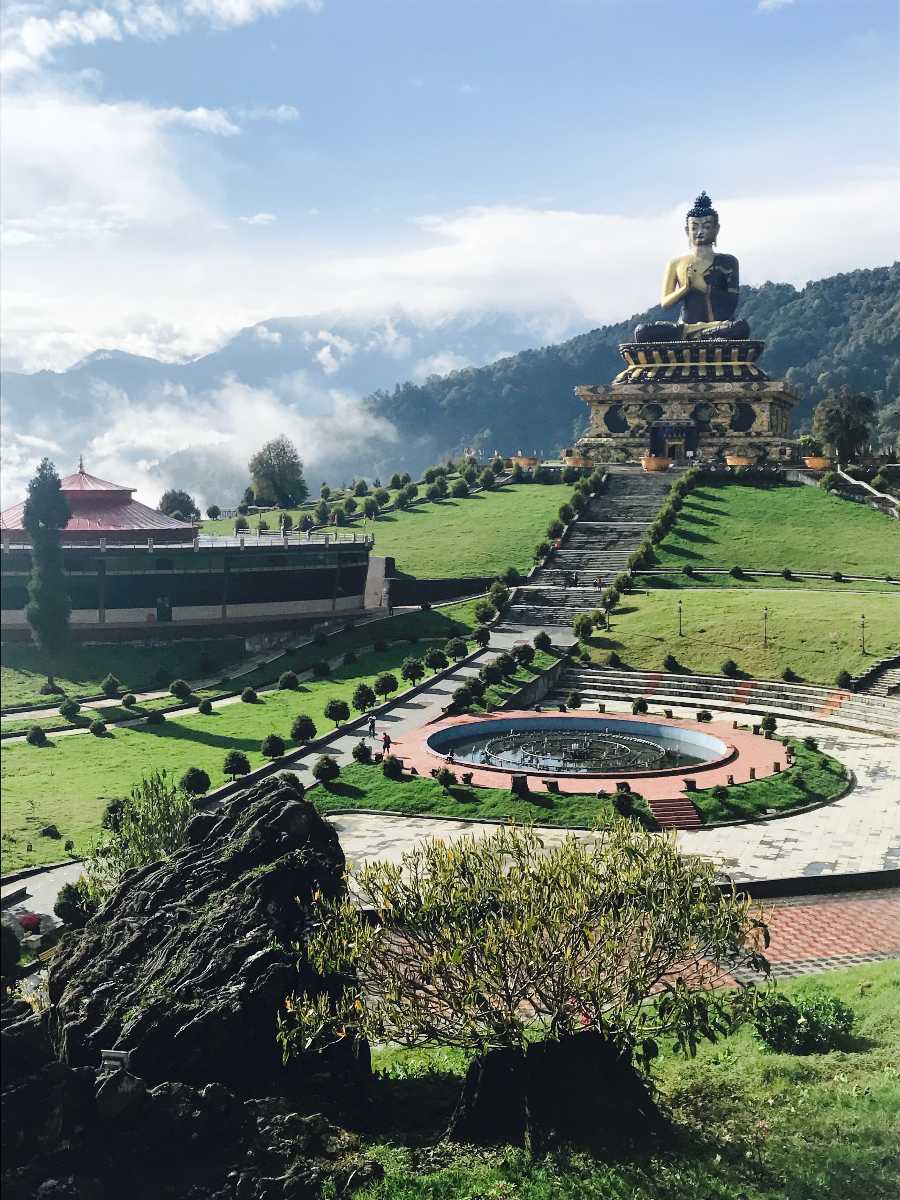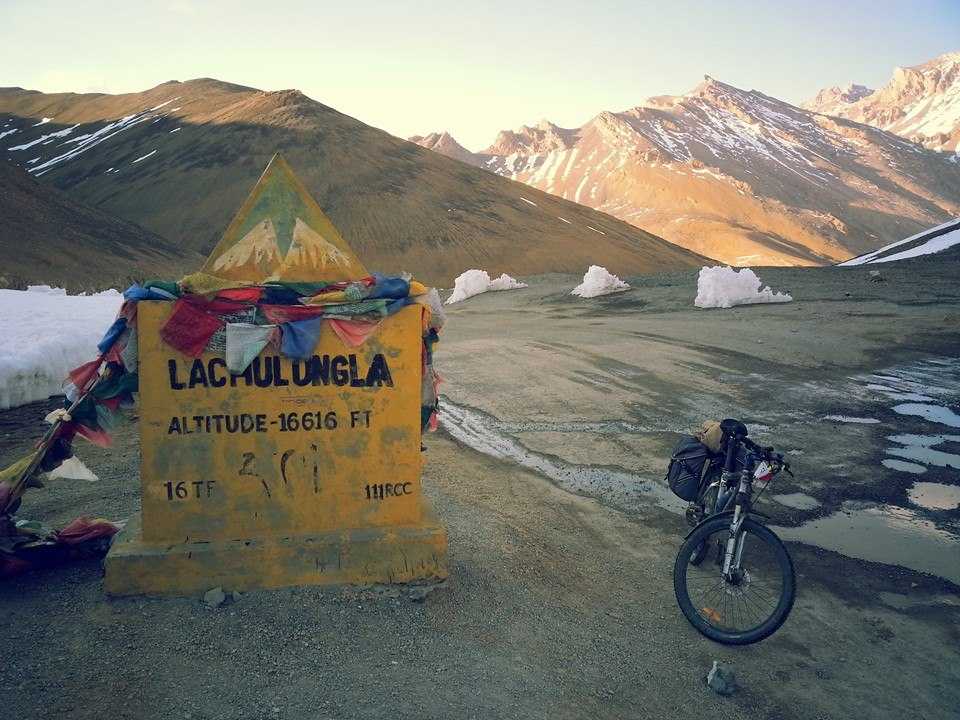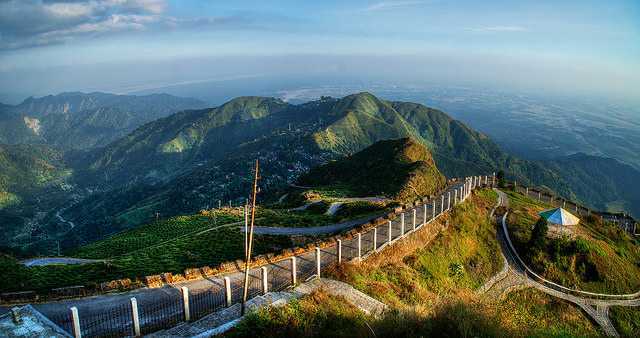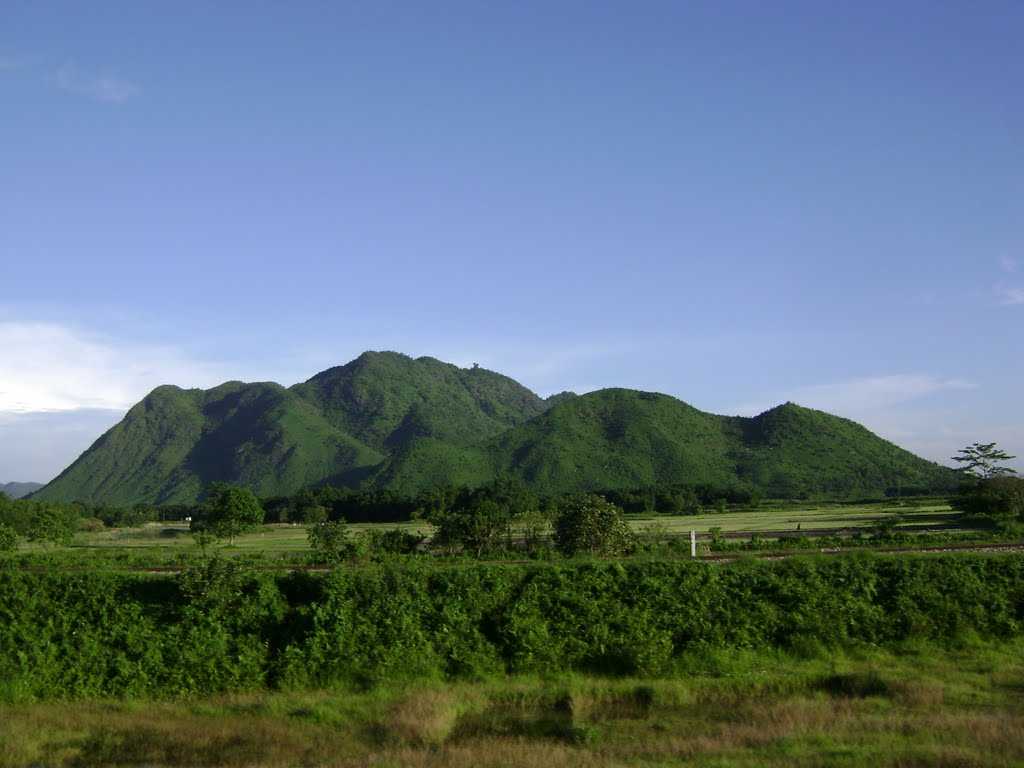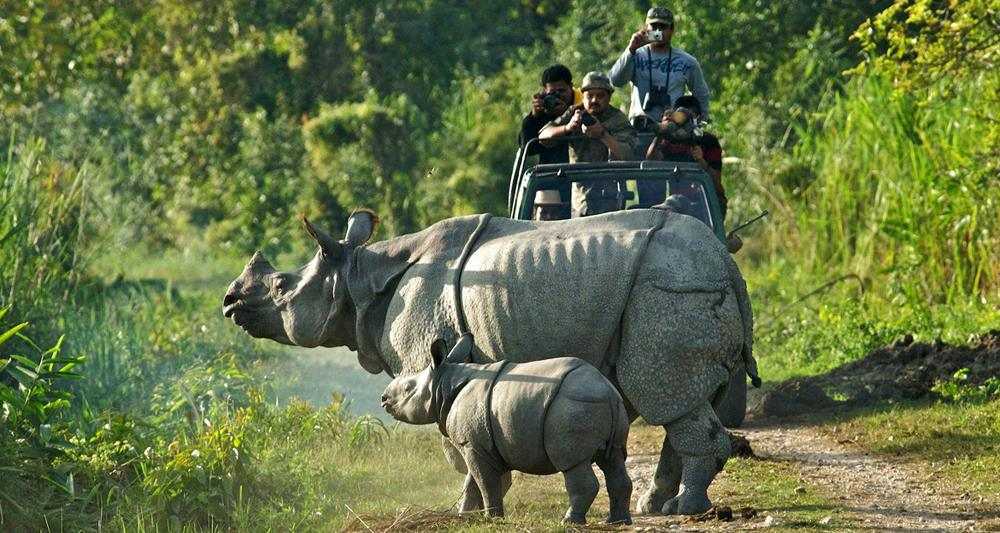GANGTOK
Hey there, fellow explorers! Are you tired of the same old tourist spots and clichéd destinations? Do you want to discover an offbeat place that's both beautiful and hilarious? Look no further than Gangtok, the capital city of Sikkim.
Imagine a place where you can sip on some hot tea while admiring the majestic Himalayas, and then, in the next moment, stumble upon a shop selling t-shirts with funny slogans like "I'm not arguing, I'm just explaining why I'm right." That's Gangtok for you!
The city is a perfect blend of natural beauty and quirky humor. You'll find breathtaking views at every corner, from the picturesque Tsomgo Lake to the magnificent Kanchenjunga Peak. But don't be surprised if your attention is diverted by a signboard reading "Free Wi-Fi: Connect with your inner self" or "Life is short. Smile while you still have teeth."
Gangtok is also a foodie's paradise, with its unique blend of Tibetan, Nepali, and Sikkimese cuisine. Don't miss out on trying momos, thukpa, and gundruk ko jhol – they'll leave your taste buds asking for more. And if you're feeling adventurous, head over to MG Marg – the pedestrian-only street that's famous for its quirky shops and street food stalls.
So what are you waiting for? Pack your bags (and your sense of humor) and head over to Gangtok – where laughter meets beauty!
Table of Contents
- Introduction
- History and Culture of Gangtok
- How to Reach and getting around Gangtok
- Weather of Gangtok
- Places to Visit in Gangtok
- Food Options and Local Cuisine of Gangtok
- Best areas for Accommodation in Gangtok
- Shopping in Gangtok
- Nightlife in Gangtok
- Festivals and Events in Gangtok
- Tips for Travelers travelling to Gangtok
- FAQs
History and Culture of Gangtok
Gangtok is a hilarious city situated in the northeastern part of India. It was established in the 19th century by the Namgyal dynasty, and it has been a center for political and cultural activities ever since. The city's culture is an amalgamation of different ethnicities, including Nepalis, Lepchas, and Bhutias.
The city's name is derived from the Tibetan word 'gangs-tok,' which means hilltop, and it lives up to its name with its magnificent views of the Himalayas. Gangtok is also known for its famous monasteries such as Enchey Monastery, Rumtek Monastery, and Tsuklakhang Monastery.
The food culture in Gangtok is unique, with momos (dumplings) being a must-try delicacy. The city also boasts of local beverages such as chang (a fermented drink made from millet), tongba (a fermented drink made from millet), and chhang (a beer-like beverage).
Gangtok is famous for its handicrafts, including carpets, blankets, and shawls made from wool. The city also has many souvenir shops that sell traditional handicrafts like Thankas (Buddhist religious paintings), prayer flags, and masks.
One of the most popular festivals in Gangtok is Losar, which marks the Tibetan New Year. During this festival, locals perform traditional dances and rituals to ward off evil spirits.
In conclusion, Gangtok's history and culture are fascinating and intriguing. From its establishment by the Namgyal dynasty to its unique food culture and famous monasteries, this city has something to offer everyone who visits it. So pack your bags and head over to Gangtok for an unforgettable experience!
How to Reach and getting around Gangtok
Gangtok, the capital of Sikkim, is a beautiful hill station situated in the Eastern Himalayas. If you are planning to visit Gangtok, there are several ways to reach this stunning destination.
By Air: The nearest airport to Gangtok is Bagdogra Airport in West Bengal, which is about 124km away. From the airport, you can hire a taxi or take a shared cab to reach Gangtok. You can also pre-book a private vehicle from your hotel or travel agency.
By Train: The nearest railway station to Gangtok is New Jalpaiguri Railway Station in Siliguri, West Bengal, which is about 148km away. From the station, you can hire a taxi or take a shared cab to reach Gangtok.
By Road: If you are traveling from nearby cities like Darjeeling or Kalimpong, you can take a shared cab or hire a private taxi to reach Gangtok. You can also take buses operated by Sikkim National Transport (SNT) or private operators from major cities like Siliguri and Kolkata.
Self-Drive: If you love driving and want to explore the scenic beauty of the hills, you can rent a car and drive yourself to Gangtok. However, keep in mind that the roads are steep and narrow in some places, so it's better to be an experienced driver.
No matter how you choose to reach Gangtok, one thing is certain – your journey will be as beautiful as your destination!
Weather of Gangtok












 Extreme Winters
Extreme Winters Mild Winters
Mild Winters Hot + Dry
Hot + Dry Hot + Humid
Hot + Humid Rainy
Rainy Cool and Pleasant
Cool and PleasantGangtok, the capital city of Sikkim, is a beautiful hill station that boasts of pleasant weather throughout the year. However, the best time to visit Gangtok is during the months of March to June and September to November. During this time, the weather in Gangtok is mild and pleasant, making it a perfect destination for tourists.
During the summer months, the temperature in Gangtok ranges between 15°C to 25°C. The skies are clear, and the weather is perfect for sightseeing and outdoor activities like trekking and camping. The monsoon season in Gangtok starts in July and lasts till September. Though the rainfall makes the place look more beautiful, it can hinder sightseeing plans.
The winter months in Gangtok are from December to February. The temperature drops down to around 4°C during this time, making it a bit chilly for tourists. However, if you enjoy cold weather and snowfall, then winter is an excellent time to visit Gangtok.
In conclusion, if you want to visit Gangtok when the weather is at its best, plan your trip between March to June or September to November. These months offer pleasant weather with clear skies and are ideal for sightseeing and outdoor activities.
Places to Visit in Gangtok
Tsomgo Lake: Located at an altitude of 12,313 feet, Tsomgo Lake is a serene glacial lake surrounded by snow-capped mountains. The lake is sacred to the Sikkimese people and is home to several species of migratory ducks and Brahmini ducks.
Nathula Pass: Nathula Pass is a mountain pass on the Indo-China border that offers breathtaking views of the Himalayas. Visitors need to obtain permits from the Indian government to enter Nathula Pass, which remains open only for a few months every year.
Rumtek Monastery: Rumtek Monastery is one of the most important monasteries in Sikkim and is home to several priceless artifacts, including ancient manuscripts and thangkas. The monastery also offers stunning views of the surrounding hills.
Ganesh Tok: Ganesh Tok is a small temple dedicated to Lord Ganesha located on a hilltop overlooking Gangtok. Visitors can enjoy panoramic views of Gangtok from here.
Enchey Monastery: Enchey Monastery is a 200-year-old Buddhist monastery located near Gangtok that features intricate carvings and paintings depicting Buddhist teachings.
Hanuman Tok: Hanuman Tok is another temple located on a hilltop that offers stunning views of Gangtok and its surroundings. Visitors can also enjoy a peaceful walk through the nearby forest.
Tashi Viewpoint: Tashi Viewpoint offers panoramic views of Mount Kanchenjunga, the third-highest peak in the world. Visitors can also enjoy tea and snacks at the nearby cafeteria while taking in the view.
Namgyal Institute of Tibetology: Namgyal Institute of Tibetology is a research institute dedicated to Tibetan studies that features an extensive collection of rare books and manuscripts, as well as traditional Tibetan artifacts and artwork.
Do Drul Chorten Stupa: Do Drul Chorten Stupa is one of the largest stupas in Sikkim, featuring intricate carvings and paintings depicting Buddhist teachings.
MG Marg: MG Marg is Gangtok's main shopping street lined with shops selling traditional handicrafts, clothing, jewelry, and souvenirs. The street also features several restaurants serving local food as well as international cuisine.
Adventures Activities
Romantic Places
Heritage Places
Relaxing Retreats
Hilly Regions
Nearby Forests
Food Options and Local Cuisine of Gangtok
Best areas for accommodation in Gangtok
Gangtok, the capital city of Sikkim, offers a plethora of options for accommodation to cater to different budgets and preferences. Here are some of the best areas for accommodation in Gangtok:
- M.G. Road: This is the main commercial hub of Gangtok and is home to a range of hotels, from budget to luxury. Many popular tourist spots like the Namgyal Institute of Tibetology and Do Drul Chorten Stupa are also located nearby.
- Tadong: Located slightly away from the city center, Tadong is a quieter area that offers some great views of the surrounding hills. It is well-connected by public transport and has a few good budget hotels.
- Deorali: Situated on a hilltop overlooking Gangtok, Deorali is known for its serene environment and stunning views. It has a few luxury resorts that offer top-notch amenities.
Here are three properties for accommodation in Gangtok:
- Mayfair Spa Resort & Casino (luxury): This five-star resort located in Lower Samdur Block offers luxurious rooms with mountain views, an outdoor pool, and an in-house casino.
- Hotel Rendezvous (budget): Situated on M.G. Road, this budget hotel offers clean rooms with basic amenities at an affordable price point.
- Zostel (hostel): Located in Tadong, Zostel is a backpacker's paradise that offers dormitory-style accommodation with shared bathrooms and common areas. It also has a rooftop terrace offering great views of the city.
Overall, Gangtok has something for everyone when it comes to accommodation options. Whether you're looking for luxury or budget options, you'll definitely find something suitable here.
Shopping in Gangtok
Gangtok, the capital city of Sikkim, is a popular tourist destination and also a hub for shopping. There are several markets in the city that offer a variety of products ranging from traditional handicrafts to modern clothing. Here are some things to buy, markets to visit and things to avoid while shopping in Gangtok.
Things to buy:
- Sikkimese Handicrafts: Gangtok is known for its unique handicrafts made by local artisans. Some popular items include Thangkas (Buddhist paintings), prayer wheels, wood carvings, and handwoven carpets.
- Teas: Sikkim produces high-quality tea and there are several tea estates near Gangtok. You can buy loose tea leaves or packaged tea from shops around the city.
- Traditional Attire: The traditional dress of Sikkim is called 'Kho' and is worn by both men and women. You can buy Kho from shops in MG Marg or Lal Bazaar.
- Jewelry: Local jewelers in Gangtok offer a range of unique jewelry made from silver, turquoise, and other precious stones.
Markets to visit:
- MG Marg: This is the main market in Gangtok where you can find almost everything you need. It's a pedestrian-only street with shops selling clothing, souvenirs, food, and more.
- Lal Bazaar: This market is famous for its fresh produce like fruits, vegetables, spices, and meat. You can also find traditional attire here.
- New Market: This market is located near the bus stand and offers a variety of products like clothing, electronics, footwear at reasonable prices.
What to avoid:
- Fake Items: Be cautious when buying branded items as there are many counterfeit products sold in the markets.
- Fur Products: Avoid buying any fur products as they may be made from endangered animals like snow leopards or black bears.
- Antiques: It's illegal to export antiques from India without proper documentation so avoid buying any antique items unless you have proof of their authenticity.
- Street Food: While street food may look tempting, it's better to avoid it as it may cause stomach problems for tourists who are not used to the local cuisine.
In conclusion, shopping in Gangtok can be an exciting experience if you know what to buy and where to shop. Make sure to explore the local markets for unique handicrafts and teas while avoiding fake items or illegal goods.
Nightlife in Gangtok
Gangtok, the capital city of Sikkim, is known for its breathtaking views, serene ambiance, and vibrant nightlife. The city has a plethora of options to offer when it comes to spending the night in style. Whether you are looking for a lively party scene or a serene ambiance to unwind, Gangtok has it all.
The nightlife in Gangtok is a perfect blend of modernity and tradition. The city offers an array of options for party lovers, including bars, pubs, discotheques, and nightclubs.
Here are three places that one can visit to spend the night in Gangtok:
Café Live & Loud: This café is known for its lively music scene and stunning views of the city. The café hosts live music events every weekend, which draws crowds from all over the city.
Club Mahindra: Club Mahindra is one of the most popular nightclubs in Gangtok. It boasts an impressive dance floor, a variety of cocktails and mocktails, and an extensive food menu.
The Local Pub: This pub is known for its cozy ambiance and excellent selection of beers and cocktails. The pub also serves delicious food that complements the drinks perfectly.
In conclusion, Gangtok's nightlife scene caters to everyone's tastes and preferences. Whether you want to dance the night away or enjoy a quiet drink with friends, there's something for everyone in this vibrant city!
Outdoor Activities in Gangtok
After a night of partying, it's time to get some fresh air and enjoy the great outdoors of Gangtok. The city offers various outdoor activities that are perfect for adventure-seekers and nature lovers alike. From trekking to paragliding, there's something for everyone.
Trekking is a popular activity in Gangtok, as the city is surrounded by hills and mountains. There are several trekking routes available that offer breathtaking views of the Himalayas and the surrounding valleys. Some popular treks include the Dzongri Trek, Goecha La Trek, and Kanchenjunga Base Camp Trek.
For those who want an adrenaline rush, paragliding is a must-try activity in Gangtok. Soar high above the picturesque city and experience an unforgettable bird's-eye view of the landscape. The best time to go paragliding is from September to November when the weather is clear.
Another exciting outdoor activity in Gangtok is river rafting. The Teesta River provides an excellent opportunity for rafting enthusiasts to enjoy the rapids while taking in stunning views of the surrounding mountains.
In conclusion, Gangtok has plenty to offer when it comes to outdoor activities. Whether you're looking for a leisurely trek or an extreme adventure, there's something for everyone here. So pack your bags, put on your hiking boots, and get ready to explore this beautiful city!
Festivals and Events in Gangtok
Gangtok, the capital city of Sikkim, celebrates numerous festivals and events throughout the year. These events reflect the cultural diversity of the region and attract tourists from all over the world. From traditional celebrations to contemporary music festivals, there is something for everyone in Gangtok.
Some of the major festivals and events celebrated in Gangtok are:
Losar (February/March): Losar is a Tibetan New Year festival and is celebrated with great enthusiasm by the local communities. The festival involves colorful parades, traditional dances, and feasting.
Bumchu (January/February): Bumchu is a Buddhist festival that is celebrated at Tashiding Monastery. The highlight of the festival is the holy water ceremony where water is poured into a pot and its level determines the future of Sikkim.
Saga Dawa (May/June): Saga Dawa is another important Buddhist festival that marks Buddha's birth, enlightenment, and death. It is celebrated with prayer flags, butter lamps, and rituals.
International Flower Festival (March/April): This annual event celebrates Sikkim's diverse flora and fauna. The festival showcases a wide variety of flowers including orchids, rhododendrons, and magnolias.
Gangtok Food and Culture Festival (December): This festival celebrates local culture through food, music, dance performances, competitions, and exhibitions.
Sikkim Winter Carnival (December): This vibrant carnival features cultural shows, adventure sports activities like skiing competitions at Mt Katao for three days along with food stalls selling traditional dishes.
These festivals provide an opportunity for visitors to experience Sikkim's rich heritage and culture. Tourists can enjoy traditional dances like mask dance or chaam dance performed during these festivals along with some lip-smacking delicacies.
Tips for Travelers while travelling to Gangtok
Plan your travel dates wisely - Gangtok is a popular tourist destination and attracts a large number of visitors throughout the year. Therefore, it is recommended to plan your travel dates wisely, keeping in mind the festivals and events that take place in the city. This will not only help you witness the cultural richness of Gangtok but also avoid the crowds and high prices during peak seasons.
Pack according to the weather - Gangtok experiences different weather conditions throughout the year, ranging from cool summers to chilly winters. So, it is essential to pack accordingly. Make sure to carry warm clothes if you are traveling during winters, and light cotton clothes if you are visiting during summers.
Follow the local customs and traditions - Gangtok has a unique culture and follows its customs and traditions strictly. Therefore, it is advisable to respect these customs and follow them while traveling in the city. This includes dressing modestly, removing shoes before entering religious places, and seeking permission before clicking pictures.
Try out local cuisine - Gangtok is famous for its delicious cuisine that offers a variety of flavors ranging from spicy to sweet. Don't hesitate to try out local delicacies like momos, thukpa, gundruk, and sel roti while exploring the city.
Stay safe and take precautions - While traveling in Gangtok, it is crucial to stay safe and take necessary precautions like carrying a first aid kit, avoiding isolated areas at night, and being aware of your surroundings. Also, keep important documents like passport and visa copies safe with you at all times.
In summary, planning ahead for festivals/events in Gangtok can help you avoid crowds; packing appropriate clothing for weather conditions will make your trip more comfortable; respecting customs will make your experience more positive; trying out local cuisine will enhance your culinary experience; following safety precautions will ensure a safe trip overall.
FAQs
What is Gangtok known for?
Gangtok is the capital city of Sikkim, a northeastern state in India. It is known for its natural beauty, picturesque landscapes, and vibrant culture. The city is surrounded by mountains, and visitors can enjoy breathtaking views of the Himalayas. Gangtok is also popular for its Buddhist monasteries, such as Enchey Monastery and Rumtek Monastery. The city has a unique blend of traditional and modern elements, with shopping centers, restaurants, and nightlife options.
How to reach Gangtok?
Gangtok can be reached by air, train, or road. The nearest airport is in Bagdogra, West Bengal, which is about 124 km from Gangtok. From there, visitors can take a taxi or bus to reach the city. The nearest railway station is New Jalpaiguri in Siliguri, West Bengal (148 km away), which connects to major cities in India. Visitors can also reach Gangtok by road from nearby cities like Darjeeling and Kalimpong.
What are some popular tourist attractions in Gangtok?
Gangtok offers numerous tourist attractions that cater to all kinds of travelers. Some of the popular places to visit include Tsomgo Lake (also known as Changu Lake), Nathula Pass (a mountain pass on the Indo-China border), Hanuman Tok (a Hindu temple dedicated to Lord Hanuman), Tashi Viewpoint (a scenic viewpoint overlooking the Himalayas), and MG Marg (the main street of Gangtok with shops and restaurants). Other attractions include Do Drul Chorten Stupa, Flower Exhibition Centre, and Namgyal Institute of Tibetology.
When is the best time to visit Gangtok?
The best time to visit Gangtok is from March to May when the weather is pleasant with clear skies and blooming flowers. Another good time to visit is from October to mid-December when the monsoon season ends and winter sets in with occasional snowfall in higher altitudes. However, it's important to keep in mind that peak season means higher prices and more crowds.
What are some adventure activities that can be done in Gangtok?
Gangtok offers many adventure activities for thrill-seekers such as trekking through rugged mountain trails at places like Dzongri Trek or Singalila Trek; paragliding over lush valleys at Reshithang; river rafting on Teesta River; mountain biking through challenging terrains; rock climbing at Tashi Viewpoint; cable car ride over scenic vistas at Rope Way; bungee jumping at Singshore Bridge near Pelling.
What are some local delicacies that one must try while visiting Gangtok?
Gangtok has a diverse food culture influenced by Tibetan, Nepalese, Bhutanese cuisines along with Indian vegetarian dishes. Some popular local delicacies include momos (steamed or fried dumplings filled with vegetables or meat); thukpa (noodle soup); gundruk ko jhol (vegetable curry made with fermented spinach leaves); phagshapa (pork curry); sel roti (ring-shaped rice flour bread); chhang (local alcoholic beverage made from fermented millet).
What are some shopping options available in Gangtok?
MG Road or Mahatma Gandhi Marg is the main shopping hub of Gangtok where visitors can find many shops selling traditional handicrafts such as thangkas (Buddhist paintings on silk or cotton cloth), prayer wheels & flags; woolen garments like shawls & sweaters; tea & spices like Sikkim Tea & cardamom; souvenirs like keychains & fridge magnets depicting local landmarks. Other markets like Lal Bazaar Market & New Market offer more affordable options for clothes & accessories along with street food stalls serving momos & noodles.
